A spray nozzle assembly includes a pressure dependent variable spray orifice and an internal chamber which is at least partially bound by a flexibly deformable... A spray nozzle assembly includes a pressure dependent variable spray orifice and an internal chamber which is at least partially bound by a flexibly deformable sidewall. At its distal end, the sidewall terminates at a distal face defining the spray orifice extending therethrough. A metering member extends distally from the internal chamber and through at least a portion of the spray orifice. As the pressure of a liquid supplied to the internal chamber by a liquid supply pathway varies, the flexibly deformable sidewall expands or contracts in response thereto. As the sidewall expands and contracts, the distal face moves relative to the metering member to change the effective size of the spray orifice. |
Background Chemical binders used in asphalt paved surfaces are subject to age hardening, resulting in... Background Chemical binders used in asphalt paved surfaces are subject to age hardening, resulting in increased stiffness over time, a major cause of cracking and the subsequent need for re-surfacing. Over the last 40 years, treating the binders with some form of anti-oxidant (AOX) has shown some promise in reducing binder stiffness, but it still is prone to softening at higher temperatures, stiffening at lower temperatures or leaching out over time. To ensure long-term durability, a viable AOX treatment should remain dimensionally stable over a wide temperature range and be environmentally and occupationally safe to use. AOXADURDeveloped by a team of researchers at the University of Illinois at Urbana-Champaign in 2006, this revolutionary AOX binder treatment consists of three additives to base asphalt: aldehyde, thioester and a caltalyst. A condensation reaction of aldehyde with asphalt to form novolacs, which can act as antioxidants, results in a reduction of age-susceptible polar aromatics in the binder. The thioester serves as a secondary antioxidant, which is highly effective against oxidative degradation of hydrocarbons. Laboratory testing of over 40 binders at the University of Illinois showed that the AOXADUR-modified binder produces the lowest aging index the measurement of asphalt aging potential during service life. Further, the AOXADUR-modified binder showed a dramatic increase in high-temperature stiffness and a substantial decrease in low-temperature stiffness. This improvement in binder properties at both high and low temperatures results in less thermal stress and reduced cracking potential. Finally, the age-fighting characteristics of AOXADUR make it an appealing choice asphalt mixtures containing recycled asphalt pavement (RAP). With AOXADUR, higher amounts of RAP material can be used, which can lead to a reduction in the amount of new aggregate and asphalt binder required per ton of mixture, leading to economic and environmental benefits and increased sustainability of the roadway materials. |
An inductive wireless power system is particularly appealing for secured short-range operation, considering its non-contacting and non-radiative nature.... An inductive wireless power system is particularly appealing for secured short-range operation, considering its non-contacting and non-radiative nature. However, one of the major challenges of inductively and wirelessly powering chip-scale apparatuses stems from the miniature size of chip-scale apparatus. The effective range of power transfer or communication is limited by the size of the coil that resides on the implanted chip or the hardware root of trust. For a distance exceeding five diameters of the coils, the power transfer efficacy diminishes to practically nothing even with high Q coils and magnetic resonance enhanced designs.
The lab employs a novel approach of treating multi-coil WPT systems as RF filters formed by spatially and weakly coupled resonators, for which the final power transfer efficacy (PTEF) can be determined similarly to the insertion loss of a filter. The effectiveness and accuracy in predicting the performance of the designed WPT systems are tested by micro fabricating the coils on a Si wafer and measuring the power transfer efficacy. The measurement and modeling results reach excellent agreement. As a result, inductive wireless power transfer over a long distance (~5 times the coil diameter) has been achieved with an unprecedented high efficacy (-27 dB). |
| System for Cleaning Fresh and Fresh-Cut Produce | |
| This invention is an "in-flight" fresh-cut produce cleaning system that removes undesired substances from the produce's... |
| This invention is an "in-flight" fresh-cut produce cleaning system that removes undesired substances from the produce's surface. It reduces the amount of chlorine/other sanitizers and water used in the fresh-cut produce cleaning process while quickly and efficiently removing organic exudate, field debris, and soil particulates. Fresh-cut produce is sent down a chute with one or more manifolds. One manifold sprays water or a water/sanitizer mix upwards at the falling produce while another manifold sprays another fluid (typically air) upwards at the falling produce in order to slow the descent of the produce and spin them, increasing the produce's exposure to cleaners. Produce then falls out of the chute onto a substrate. | |
|
Dr. Gruev from the University of IL has developed a bio-inspired polarization camera. The camera enables high-resolution imaging in less ideal lighting with high... Dr. Gruev from the University of IL has developed a bio-inspired polarization camera. The camera enables high-resolution imaging in less ideal lighting with high dynamic range of around 140dB. This low-cost camera has potential for application in automobile imaging and agricultural remote sensing. Publications - Missael Garcia, Tyler Davis, Steven Blair, Nan Cui, and Viktor Gruev, "Bioinspired polarization imager with high dynamic range," Optica 5, 1240-1246 (2018) |
Prof. Daniel Tortorelli and Mr. Felipe Fernandez Ayala from the University of Illinois have developed a system and method for optimal toolpath generation for additively... Prof. Daniel Tortorelli and Mr. Felipe Fernandez Ayala from the University of Illinois have developed a system and method for optimal toolpath generation for additively manufactured composite structures. With this techniques, it is easy to impose Direct Ink Writing (DIW) manufacturing constraints such as no overlap, no sag of just-printed material, minimum radius of curvature of each toolpath, and toolpath continuity. In addition, to minimize manufacturing cost, the system formulates and solves a travelling salesman problem to obtain the shortest continuous toolpath for each layer that avoids overlap and crossing holes.  
|
Dr. Zhang has developed a flow regulator that is light and small enough to be built into every actuator. The micro pinch value specifically controls the cross-section area... Dr. Zhang has developed a flow regulator that is light and small enough to be built into every actuator. The micro pinch value specifically controls the cross-section area of the flow channel according to the voltage applied to it. The flow regulator reduces the number of tubes typically needed for fluid-driven soft robots and reduces need for sealing components. It also simplifies design to actuator pressure supply, resolving the scalability problem of fluid powered robots. The embeddable component facilitates onboard control and modularity to enable soft robots to have many degrees of freedom of motion. Increased degrees of freedom of motion equips soft robots the capability to preform complex tasks. ApplicationsPrimary uses for soft robotics are within medicine and agriculture. Benefits of using the flow regulator include augmented capabilities of agricultural robots to enhance safe co-working among human labor and increased efficiencies of careful handling of soft crops. 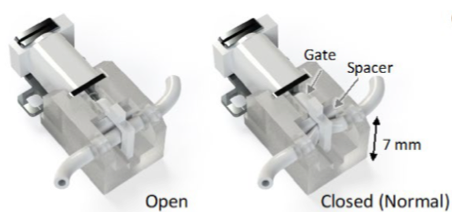 Rendering of the micro pinch valve Rendering of the micro pinch valve
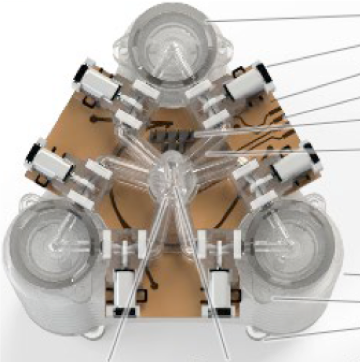 Onboard controls for the micro pinch valve Onboard controls for the micro pinch valve 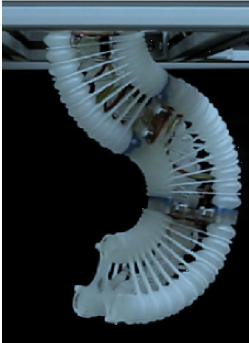 Modularity enabling many degrees of freedom Modularity enabling many degrees of freedom |
360 degree attitude control of satellites is an aerospace technology that allows satellites and spacecraft to achieve arbitrarily large (360°+) rotations in a low- and no-... 360 degree attitude control of satellites is an aerospace technology that allows satellites and spacecraft to achieve arbitrarily large (360°+) rotations in a low- and no-atmosphere environment. This hardware technology achieves attitude adjustment without the use of a consumable propellant or constantly spinning flywheels. Use of propellant exacerbates jitter interferes with satellite function, while spinning flywheels requires failure-prone sliding contacts. The invention instead features variable-length appendages that utilize transverse oscillations and moment of inertia adjustments to achieve both fine and arbitrarily large rotations. By lengthening the appendage for an “up-stroke” and shortening it for the “down-stroke,” an angular momentum differential is created to allow the satellite or spacecraft to return to its original position/state, but reoriented in a different direction (with respect to a static “space” frame of reference). Repeating the “strokes” allows for arbitrarily large net rotations. The technology was presented at the ASME Conference in September 2019. Application360 degree attitude control is applicable to spacecraft and satellite manufacturers that serve primarily consumer industries such as TV, radio, broadband, mobile, and earth observation services. 
Prototype model of 360 Degree Attitude Control of Satellites 
This rotational mechanism for attitude control is repeated as many times as necessary to achieve the desired orientation. |
This geopolymer was developed through a collaboration between Professor Waltraud Kriven at the University of Illinois and the Construction Engineering Research Laboratory... This geopolymer was developed through a collaboration between Professor Waltraud Kriven at the University of Illinois and the Construction Engineering Research Laboratory (an entity of the U.S. Army Corps of Engineers). The concrete alternative is made from a geopolymer-based flowable binder, the supplementary cementitious materials fly ash and blast-furnace slag, alkali metal silicate, and added water. Fly ash is a byproduct of coal combustion, while slag is a byproduct of steel manufacturing. Repurposing fly ash and slag, which are considered raw waste materials, reduce emissions of CO2 by reducing the proportion of clinker produced in the Portland cement manufacturing process. Use of fly ash and blast-furnace slag in this concrete alternative is environmentally friendly and enhances the performance of key concrete properties including strength, set time, and workability. The geopolymer concrete mixture is ideal for applications requiring a short set time and high strength development, including roadway repair and general construction within warmer climates. This invention is patent pending (application number 16/255,131). 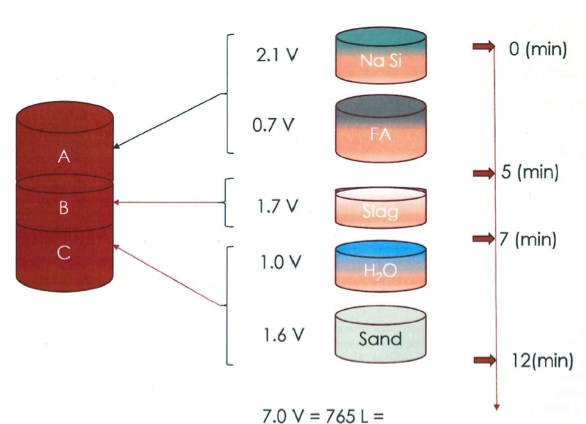
The flowable geopolymer binder may be deployed and mixed in a drum for increased flexibility in a range of applications. 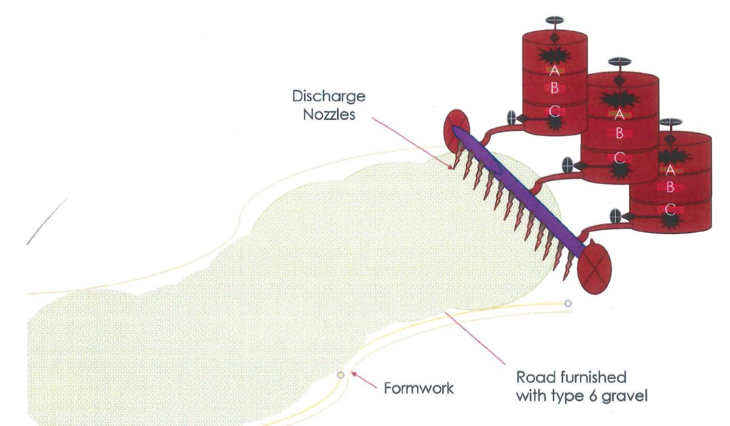
The flowable mortar is distributed over a bed of coarse aggregate, curing rapidly to create a stronger, more environmentally-friendly concrete alternative. |
Dr. Andrawes at the University of Illinois has developed a unique method for localized concrete repair and strengthening. A precast plate of concrete or mortar, which... Dr. Andrawes at the University of Illinois has developed a unique method for localized concrete repair and strengthening. A precast plate of concrete or mortar, which contains a curved, self-anchored SMA wire, can be attached to an area of concrete in need of repair. Upon heating or passing electric current through the exposed ends of SMA wire, the restrained wire induces compressive force in the center of the plate. Since the SMA wire is self-anchored, there is no need for an external anchorage system. Additionally, since the prestressing is activated by the application of heat or electricity, there is no need for hydraulic jacking. These characteristics make this technology a flexible, and cost-saving method for localized structural repairs. Primary application: Precast/prestressed concrete products 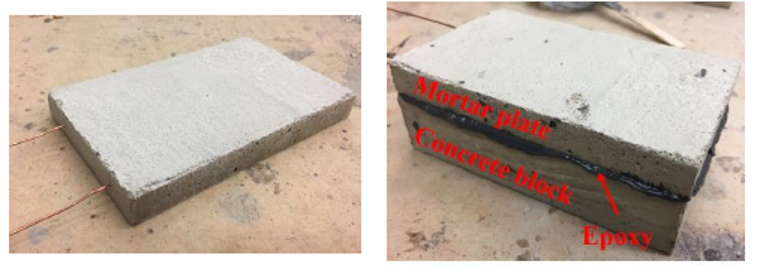
|
James Allison and researchers from the University of Illinois have developed a technology that provides fine pointing and large slew attitude control for... James Allison and researchers from the University of Illinois have developed a technology that provides fine pointing and large slew attitude control for satellites and spacecraft with a power electronics driver circuit that improves the power efficiency of the system by at least one order of magnitude. The invention features a dedicated compliant actuator on a vehicle to produce the torques to achieve arbitrarily large rotations around all axis without the jitter limitation of other attitude control system. |
Researchers have developed a novel design strategy that mitigates the formation of vortices across the rotor near-wake region. The unique design aims to reduce thrust... Researchers have developed a novel design strategy that mitigates the formation of vortices across the rotor near-wake region. The unique design aims to reduce thrust distribution across the tip region in order to mitigate the formation of energetic, coherent vortices at the blade tip. The invention features a unique geometrical rotary wing design that creates zero vortices at the wingtip allowing noise reduction generated by blade-vortex interactions. This invention could be used for lifting rotors or propellers on standard helicopter flight vehicles, other vertical lift aircraft, and turbines with minimal effect in total rotor efficiency. 

|
Researchers from the University of Illinois have developed an accurate, low-cost star tracker system for deployment in small satellites. The system combines multiple low-... Researchers from the University of Illinois have developed an accurate, low-cost star tracker system for deployment in small satellites. The system combines multiple low-cost image sensors with proprietary software to achieve superior performance from a simple, lightweight star tracking solution. With its easy implementation and component costs at just hundreds of dollars, this device can dramatically increase the accessibility of quality attitude determination for CubeSat, NanoSat, and other missions. The star tracker may also be adapted as a positioning system for select terrestrial vehicles that would benefit from greater security and reliability than conventional GPS. Benefit A cheaper, and more compact method to make star trackers for satellites. Easier to make than current methods which makes the tracker more broadly applicable for different satellites. Market Application Best used for CubeSats which have difficulties determining their orientation |
An energy harvester and displacement transfer system that converts mechanical energy from vehicles passing over system to electrical energy, using a rack-and-pinion... An energy harvester and displacement transfer system that converts mechanical energy from vehicles passing over system to electrical energy, using a rack-and-pinion mechanism and displacement plate. The system harnesses energy at highway speeds. The size of the system is relatively small to ensure its embedment within 4 inches (two asphalt lifts). Hence, it can be integrated in a pavement with minimal modifications. BenefitsMarket Application |

